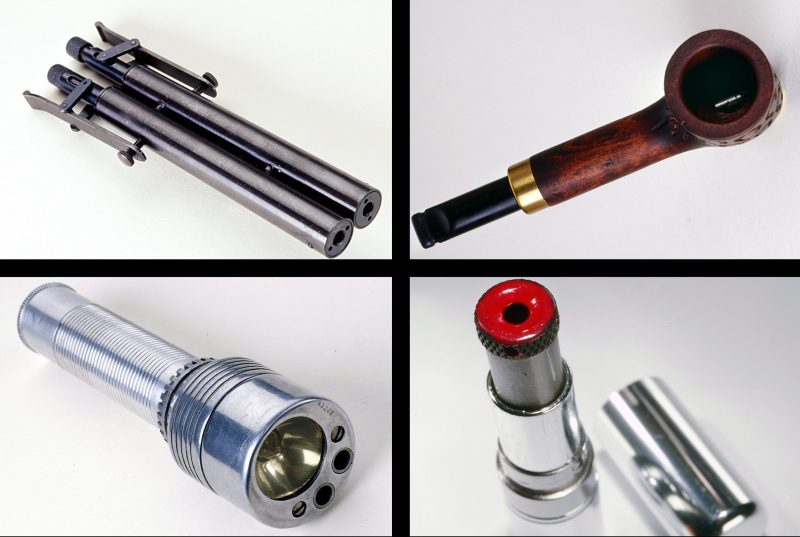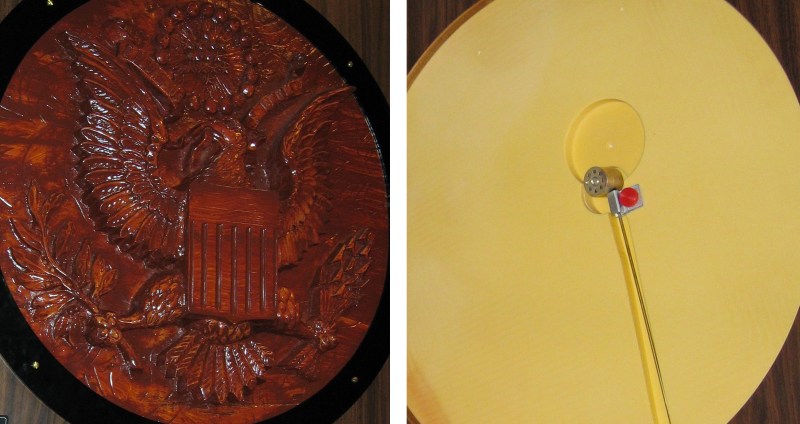
Technology has always played a major role in espionage, but the inverse has also proved true.
From aerospace and telecommunications to computers and the Internet, consumer tech has been shaped by spies throughout modern history.
The first text messaging system was developed by the CIA in the 1970’s but it was ahead of its time. Short-Range Agent Communications (SRAC), as the SMS predecessor was called, required two people be near each other with shoe-box sized devices to send messages. The anachronistic tech would actually have attracted more attention than the brush-pass or dead-drop techniques it was invented to supposedly supplant.
Espionage is a matter timing as well as technical prowess. That basically means inventing technology faster than your rival’s counterintelligence. Even the most cleverly disguised camera or weapon isn’t useful if the adversary knows it’s there, but it can be invaluable if they don’t.
“The Thing” is a perfect example.
In 1945, a group of Moscow schoolchildren presented the U.S. Ambassador to the U.S.S.R. with a gift to symbolize the budding “friendship” between the two nations. It hung in the Moscow embassy’s study until 1952, when a passive listening device hidden inside was discovered. For six years, Soviet spies had an ear inside the embassy. It wasn’t picked up by conventional means because it didn’t give off any electromagnetic radiation since it contained no active electronics.
“The Thing” was only activated when Soviet agents on the street outside turned on a device called a microwave wave transmitter. The device is considered to be a predecessor of RFID technology, which is commonly used today to track products in manufacturing, as well as livestock and house pets.
“This was arguably the greatest signals intelligence coup of all time,” said curator and historian at the International Spy Museum, Dr. Vince Houghton. The Soviets were able to collect intelligence on American operations during the most important moments at the dawn of the Cold War—including the Marshall Plan and the Truman Doctrine, the reaction to the testing of the Soviet atomic bomb and the Korean War.

Houghton says he finds the dynamic of challenge and response between rival spy agencies fascinating. The cycle has contributed to the rate of technological innovation in the 20th and 21st centuries.
“It’s an offensive-defensive pendulum swing. Someone will invent a new an innovative technology that allows you to collect information better and very quickly, the counterintelligence guys are developing a technology to defeat that earlier technology,” Houghton explained to RealClearLife.
This dynamic kind of resembles the iconic “Spy vs Spy” comic featured in Mad Magazine. It may seem like one side has the upper hand until an unanticipated exploit suddenly tilts the playing field. But in real life, the majority of real espionage operations is a less violent gathering of information.
Despite a diminished economy crippled by reparations, the East German State Security Service (or Stasi) were especially proficient at that innovation. Or, as Houghton says, the Stasi were “exceptionally good at seeing without being seen.” For example, they developed ways to see through walls and cars using infrared cameras—a relatively advanced feat given their limited resources.
In most cases, though, each side is spending billions of dollars in research and development to invent new ways for spying. As a result, technology got more efficient and smaller. “All of the things we’re looking at were invented a long time ago, but they’re just getting better and better,” Houghton said.

The most obvious example of this trend, Houghton explains, is in bugs, or hidden listening devices. In the 1940’s, they were the size of soda cans. Today, these bugs are so well crafted and creative, they can be slipped into just about anything—an earring, a necklace, a shirt button, or even a tooth filling. Battery power is a limiting factor currently, but it likely won’t be for long.
To avoid bug detection, British intelligence skipped the tiny microphones altogether. Instead, they recorded sound vibrations in the rebar of a building in the 1970s. They would then use an advanced computer—for the time period, anyway—to translate the sound vibrations into conversations.
Illustrated by the rate of shrinking microphones, the offensive-defensive pendulum only swings faster with faster with time. Houghton points out that a six-year operation like the Soviets launched for “The Thing” wouldn’t happen today simply because tech advances at an exponential rate. “This back and forth between cyber and counter cyber spurs innovation,” Houghton explains. “Well, that’s happening in the espionage world and even with higher stakes.”
“That’s made life very, very hard for everyone—both the people creating new and innovative ways to spy on other people and also those who job it is to prevent that from happening,” Houghton said. It can be difficult for the public to get a sense of this since most is classified, but sometimes what is declassified speaks volumes.
At the International Spy Museum, curators used to have to wait 15-20 years before a piece of spy technology was shown in a museum, to avoid disrupting ongoing operations. Today, “having the ‘cutting edge’ means changing an exhibit every month or two,” Houghton explains. The museum has objects in its collection that were in use just a few months ago, but the intelligence community already considers 100% obsolete.
The offense-defense pendulum swings fastest in cyberspace, as each cyber attack against an adversary is rarely used more than once. Advances in quantum computing will only quicken the pace. However cutting-edge those capabilities may become, there will still be a need for spying outside of cyberspace.

Houghton thinks the next phase of spy gadgets will borrow tricks from the animal kingdom. Stanford University researchers already created gecko gloves that let someone scale a building in a lizard-like fashion. Chameleon-like camouflage, where a spy could be completely invisible, is likely in the works too, he says.
Ultimately, the future of espionage revolves around human enhancement such as neural laces, basically a brain/computer interface, and robotic prosthetics. If neuroscience and computing advances to a point where brain implants allow two people to communicate without talking, “That’s as good as it gets,” Houghton said. Intelligence could be collected from a source at any time without meeting them. Special operations forces could descend on their target with a bigger advantage in stealth.
“We’re nowhere near that now, but I think people are moving in that direction,” added Houghton.
—Matthew Reitman for RealClearLife
This article was featured in the InsideHook newsletter. Sign up now.























